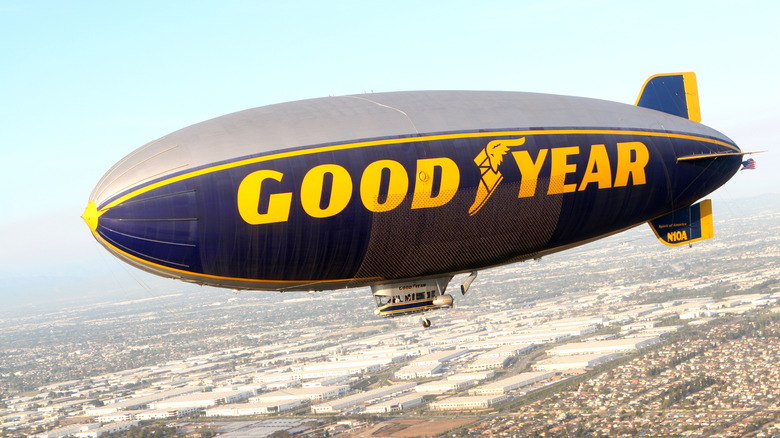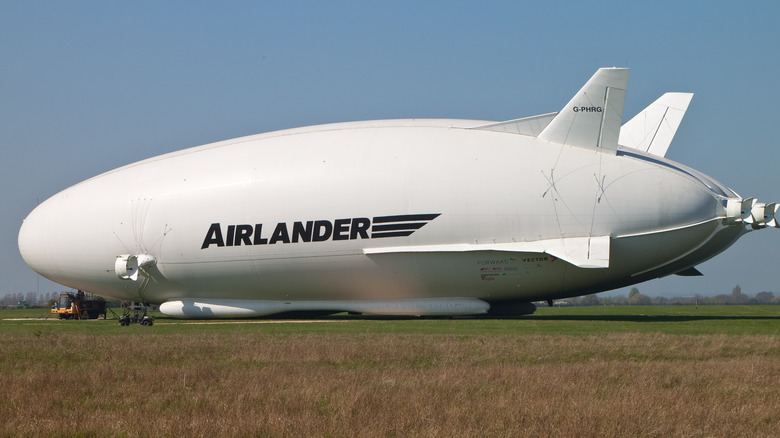The Mind-Boggling Truth About Blimps
Everyone knows what a blimp is, but you're unlikely to have seen one of the large airborne transport vessels cast a shadow over your home town — with good reason. The blimp was a natural follow on from the hot air balloon, which first appeared in the late 18th century. By the 1850s, the powered airship had arrived, offering more control, longer range, and an increased passenger count.
Dirigibles, the class of vehicle that includes blimps, continued to rise in popularity in the following decades. One particular rigid airship picked up the name "Zeppelin" from its inventor, Count Ferdinand von Zeppelin. Von Zeppelin was an aviation enthusiast and German aristocrat whose advanced stye of dirigible design fast became the standard to beat, according to Zeppelin History. It included tail fins, rudders, an internal combustion engine, and a metal frame.
If we're being technical, rigid and semi-rigid airships are not blimps. The term blimp denotes a type of dirigible without structure. It's just a large, powered, gas-filled, balloon (via How Stuff Works). However, popular culture lumps them all together, and they're all equally rare sights outside of steampunk fiction, proto-metal album covers, and Grand Theft Auto V. So why is that?
The Hindenburg was a turning point
If you ask someone to name a blimp, the chances are they'll reference the Goodyear Blimp, or the Hindenburg. Referencing the Hindenburg would be wrong, as while rigid airships and blimps are both dirigibles, they are actually separate things. Still, the 1937 disaster which saw the New Jersey-bound craft ignite, crash, and kill 35 people, had a huge impact on people's willingness to travel around in what is basically a fan-powered, balloon, according to Live Science.
As devastating as the footage of the Hindenburg disaster looked, the majority of people on board survived, 62 of 97 in total, actually survived the crash. Most of the survivors leapt to safety as the Hindenburg was going down. The zeppelin, which was filled with highly flammable hydrogen as opposed to the inert helium similar craft are filled with today, took just 34 seconds to burn. The exact cause of the ignition is unknown, though a theory popular among experts blames electrostatic discharge.
The fate of the Hindenburg, along with its association with Nazi Germany, brought about the end of the airship era. Don Adams, who works for the historical society responsible for maintaining the Hindenburg crash site, explains: "No one wanted to fly with hydrogen ships anymore; they were afraid of it. Not only that, as Hitler gained more power, people really didn't want to fly on a Nazi airship" (via Live Science).
Blimps and their pilots are pretty rare
You're unlikely to see a blimp hovering above your town because there are frankly very few left in existence. As a mode of transport, it is staggeringly rare. Reader's Digest claims that, as of 2021, the "consensus is that there are about 25 blimps still in existence." To put it in perspective, the McLaren F1 is an incredibly rare car, but there were more than four times as many F1s made as there are blimps on earth. And that's just a specific kind of super car, not an entire vehicle class.
Of the remaining 25 blimps, "around half" are used for advertising purposes. These advertising blimps are owned by just a few companies. Goodyear, which has been building blimps to slap its logo on since 1925, currently has four: Wingfoot One, Two, and Three, and the creatively titled "Europe Blimp." Metlife has three, but they no longer feature the classic cartoon character "Snoopy" or show up at sporting events.
But there is also scarcity of blimp pilots. There are just 128 people licensed to fly blimps in the United States, and only 17 people do it as a full time job (via Reader's Digest).
Cost might be keeping blimp numbers down
Cost could be a reason for the decline in sky ship numbers. They're expensive to build, requiring lightweight aluminum alloys, space-aged materials like carbon fiber, a large airtight balloon, and numerous other challenging parts. An updated version of one of the most famous blimps, the Goodyear, cost over $20 million to build (via Business Insider). Then the large, expensive, airtight balloon has to be filled with helium. The gas is the second most abundant element in the universe after hydrogen. It's also the second lightest, so it tends to float up beyond our reach once it's released into the atmosphere. It's also inert, which means it doesn't bind to things like hydrogen does, if there was a "hydrogen shortage" we could simply plunder the oceans for more. Helium is only really found in pre-existing deposits on earth — and it is in quite high demand.
Blimps and party balloons aren't the only uses for helium, it is also useful in medical devices, cooling systems, and nuclear reactors. The scarcity, along with the fact it isn't purely a novelty, means helium is expensive. It also takes a lot to fill a blimp, with Readers Digest putting the price tag at around $100,000 worth of the inert gas per flight. And the cost is still going up. Cheaper options have also replaced some blimp functions. For example, drones can now easily and safely capture aerial shots. So in most cases, a blimp simply isn't worth building and the ones still around may not be worth running.
There are numerous ongoing attempts to bring blimps back
There's an argument that, despite the cost of helium, blimps can be used to transport people and freight across large distances cheaply and with less impact on the environment. They can also land without a runway, meaning blimp transport hubs don't need the same level of infrastructure and incur the same costs airports do (via Wall Street Journal).
One project based around this logic was the Airlander 10 which took to the skies in 2016. The 302-foot long aircraft, alleged to be the largest in the world at the time of launch, is capable of cruising at altitudes of 16,000 feet and hitting speeds of up to 90mph. More recently, the Canadian province of Quebec has made a deal with aviation company Flying Whales, aimed at building a "200 meter long" airship capable of transporting 60 tons of cargo over vast distances. Around three Hercules planes would be required to shift a similar weight.
Trans-Atlantic luxury airship travel is also back on the agenda. Robb Report claims multiple companies in Europe and the United States are planning to build spacious, high-end, zeppelins that will transport high class passengers over long distances. One of the proposed ideas even breaks away from the traditional, cigar-like, airship shape and opts for a round style of balloon — similar to a donut, or a very fat flying saucer. So you may not have seen a blimp in recent times, but as the world gets more environmentally conscious there is a good chance you'll see a cargo-blimp full of goods or an airship full of very rich people slowly floating above your house in a few years.




